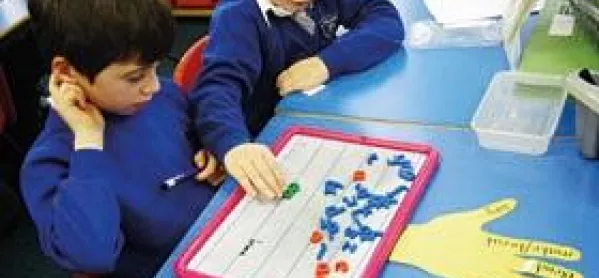For Active, read big boon to literacy

North Lanarkshire’s Active Literacy programme, now in its seventh year, is showing a significant impact - particularly in reducing the number of children who really struggle with reading and writing skills.
Nancy Ferguson, senior educational psychologist, who has worked closely with teachers in the council’s literacy base, reports both a rise in the scores of children who have followed the programme compared with the control group, and a significant reduction in the number who score below the UK average in standardised tests.
Analysis of P4 children in North Lanarkshire this year shows only 4 per cent of Active Literacy pupils below the UK average, compared with 19 per cent of pupils in the comparator group. In P5, only 1 per cent of the Active Literacy sample fell into the “below average” range, compared with 9 per cent in the control group.
The proportion of pupils scoring in the “above average” section has also risen among those following the Active Literacy programme - 73 per cent versus 41 per cent for P5; 60 per cent versus 27 per cent for P4.
The authority is now piloting Active Literacy strategies for P6-7 pupils and plans to extend the programme into S1-3. Eight principal teachers of English in secondary are already working with primary colleagues.
The chair of the Scottish Literacy Commission, Judith Gillespie, suggests this type of approach should become “the Scottish norm”.
“It is particularly encouraging that these results show improvement can be sustained as children move up the school,” she said.
The programme has been phased in over seven years; from this year, all P1 children will be taught using Active Literacy.
In the most recent set of tests, P2 Active Literacy children had an average standardised score of 102, compared with 92 for the control group, for text reading measured by standardised tests from Reading Now and GL Assessment and Learning.
P3 and 4 scores on reading comprehension (using the Neale analysis of reading ability: GL Learning) showed a similar pattern: P3 - average of 111 versus 99; and P4 - 112 versus 102.
Anything in the range of 100-110 would be a “good score”, according to Ms Ferguson.
“For our average children in North Lanarkshire, an authority with high levels of deprivation, to be getting scores of 110 and above on comprehension measures makes us delighted,” she said.
“The 4 per cent of P4 children following Active Literacy who are below average could be children with severe dyslexia. What we are being left with in this section now are children with quite significant needs.”
elizabeth.buie@tess.co.uk
Strategies for success
Key elements of Active Literacy The adaptation of synthetic phonics, writing, dictation and tactile work using magnetic boards, Plasticine and other media in early primary. Strategies such as different-coloured pencils for practising writing (rainbow spelling), “cheer” spelling (making body shapes to match letters) and “echo” spelling (when a pupil partner echoes the same body shapes back to underline the method). For children with additional support needs, a focus on “play learning” and small, achievable targets. An emphasis on active, multi-sensory tasks which encourage pupils to work co-operatively, teaching each other, and thus reinforcing their own learning, alongside whole-class instruction by the teacher. Worksheets and low-level tasks are virtually obsolete, and teachers use a wider selection of graded reading books which have less of a gap between levels. Upper-primary pupils use a wide range of real novels which engage them more and stimulate writing tasks; A six-step strategy to support pupils’ comprehension in upper primary. RAISED MOTIVATION HAS PILOT PRIMARY FLYING Kildrum Primary in Cumbernauld is one of 12 schools piloting Active Literacy for P6-7. Its P5 pupils have followed the programme since P1. Headteacher Myra Lindsay sees a “significant impact on the level of engagement and motivation of our children” - and there has been a knock-on impact on behaviour across the school, she believes. “They are eager to read and write, which was always a challenge we faced before, particularly with boys in P6-7,” she says. Mrs Lindsay believes the programme is more about the “teaching of reading than the hearing of reading”, with an increase in staff awareness of the reading process. The P6-7 work on comprehension strategies is a very concentrated approach: for five weeks, the whole class works on one novel; four days per week are devoted to reading and one to taught writing. Where necessary, individual pupils will do additional work on phonics and spelling. The approach involves: discussion of prior knowledge; looking at vocabulary; looking at the context of words and using dictionaries or a thesaurus; using a graphic organiser to examine what has happened in a chapter; character descriptions; looking at inference; discussing the main ideas; writing summaries. Of Kildrum’s 42 pupils in P5, only one is not at or above the UK average - Mrs Lindsay says the school has tried every strategy in its range, but because of this boy’s particular learning difficulties, he is still struggling with literacy. “It’s not a cure-all,” she cautions. But for others, such as those who have English as a second language, the programme has been “wonderful”. The senior management team’s role is crucial in the programme’s success, she says. They must be proactive and participative; know all the teaching and learning approaches; lead the learning; put in place robust monitoring and tracking; and benchmark children. P7 teacher Elaine Wren says: “I feel I understand the novels more because I am practising and modelling the strategies - I am getting in there with the pupils.”
Keep reading for just £1 per month
You've reached your limit of free articles this month. Subscribe for £1 per month for three months and get:
- Unlimited access to all Tes magazine content
- Exclusive subscriber-only stories
- Award-winning email newsletters